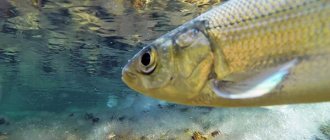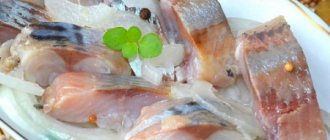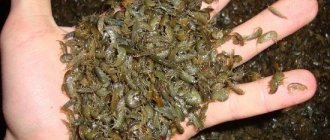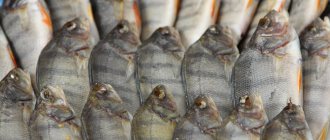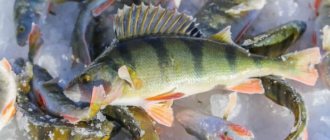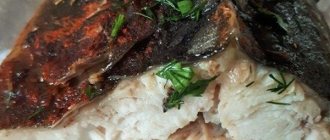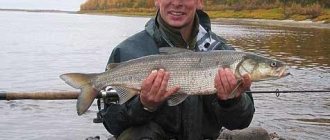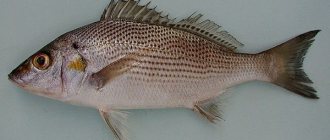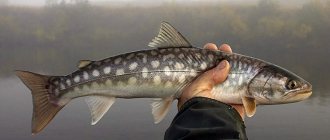One of the most valuable fish of the salmon family is omul. Its meat is very healthy and is considered dietary. Due to the decrease in the number of these fish, a fishing ban has been introduced since 2021. In Lake Baikal you can’t even catch it with a fishing rod. But still there is very little omul and it is quite expensive.
| Class | Ray-finned fish |
| Squad | Salmonidae |
| Family | Salmonidae |
| Genus | Sigi |
| View | Omul |
| Security status | Not endangered, but fishing is prohibited in some places |
| Size | Up to 64 cm, up to 3 kg |
| Lifespan | 15-20 years |
| What does it eat? | Crustaceans, invertebrates, small fish, zooplankton |
| Optimal feeding time | All year round, good night fishing in summer |
| Enemies | Unknown |
| What do they bite on? | Crustaceans, fry, flies |
What does it look like
Many people know what omul looks like, since it can often be found on sale fresh frozen or smoked. This is a small fish, its size does not exceed half a meter. Usually there are individuals 30-40 cm, Baikal varieties are even smaller. Despite the fact that some individuals can grow up to 3 kg, fish weighing more than one and a half kilograms are rarely found.
The body of the omul is narrow, elongated, tapering towards the tail, and covered with small scales. At the same time, its back is darker, its sides can have an emerald tint, and its belly is almost white. If we look at the photo and description of the omul fish, we can note the following features of its appearance:
- A lateral line runs along the body, as in all salmonids, but sometimes it is almost invisible;
- the back can be brown or green;
- there is a small adipose fin on the back near the tail;
- all fins are light;
- the head is small, the mouth is straight, located below;
- Silver eyes are large and round.
The description of the Baikal omul is practically no different from this. Only its size is smaller, it rarely grows to 35 cm. Due to the fact that it lives in fresh water and the living conditions are not so harsh, it is not very fat.
Omul is over, eat peled
17:32, October 16, 2021
This is the phrase we expected to hear from fish traders in the markets of Irkutsk. We miscalculated. It turned out to be easy to get hold of the Baikal delicacy. But maybe they are deceiving us after all and offering us the same peled under the guise of omul? Learn simple tips on how to distinguish one fish from another right now.
Unfortunately, your browser does not support HTML5 video in WebM with VP8 or MP4 with H.264.
This silvery fish is essentially a cousin of our omul. As relatives, they are expectedly similar, and for a mere mortal, distinguishing one fish from another is a difficult puzzle. But the sellers are experienced people; they immediately tell you what to pay attention to first.
- The tips of the fins are black, these are white. This is the Baikal omul.
- Here it is, this is a peled, it has completely different scales. Peled, she's fatter. But it tastes so mushy. Omul, it’s so plump and much tastier.
Due to the shortage, the price of omul has increased significantly. Minimum 400 rubles per kilogram of lightly salted. But the surrogate, peled, is not much cheaper.
Some sellers openly write the type of fish on the price tags. And they claim that peled is tastier. To finally understand this confusing story, we bought both omul and peled. And for the purity of the experiment, also one herring. First, we will conduct a tasting, and then we will announce the verdict of an independent examination of representatives of science - ichthyologists.
This summer, the Department of Vertebrate Zoology also dealt with the question of why peled is better than omul. True, in terms of artificial breeding. The head of the department, Arkady Matveev, knows any fish by sight and shared a simple way to distinguish omul from peled. “If we open the mouth, we see that here we have a clearly terminal mouth, that is, a mouth that opens right at the end of the head. There is no snout platform, so-called above. These are two specimens of omul. And here we see a peled, it has a small cartilaginous growth that protrudes slightly above the lower jaw,” said Arkady Matveev, professor, head of the department of vertebrate zoology at ISU.
According to scientists, it is necessary to prohibit not only fishing, but also the sale of omul. Then the number of the Baikal endemic will recover faster. In the meantime, sellers, in order to evade responsibility, may start selling forbidden omul under the guise of harmless peled. And to prove a violation of the ban, a serious ichthyological examination will have to be carried out.
Where does it live?
Omul is a migratory fish. This means that it lives in the sea, but descends into rivers to spawn, often traveling very far. Its habitat is the Arctic Ocean. This helps to understand where omul is found. It descends into the rivers of Siberia, Canada and Alaska. In Russia it is found in all Siberian rivers except the Ob. This is the Arctic or Yakut omul. There is also a variety that lives in the Far East, it is also called Amur, but there is little of it there.
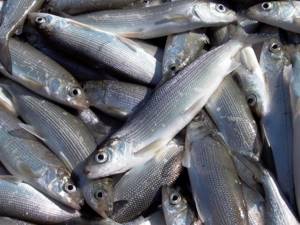
The most famous is the Baikal omul. Its meat is most prized and considered a delicacy. But now catching it is prohibited, as its number has sharply decreased. In the lake itself, this fish is unevenly distributed. It is not found on the northwest coast. Most likely, because his favorite food, crustaceans, is not there. Omul is found where rivers carry silt rich in these crustaceans into the lake.
Most of it is in the south and in the area called the Small Sea. It is the Malomorsky omul that is considered the most delicious. According to their habitat, the following varieties are also distinguished:
- ambassadorial;
- Selenga;
- North Baikal;
- Chivyrkuisky;
- Barguzinsky
In addition, depending on the place where the fish most often feed, coastal, deep-sea and pelagic varieties are distinguished. The latter stays in the water column and grows the most.
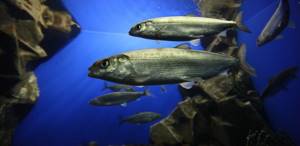
Important!
The Baikal and Arctic varieties may differ in appearance and nutritional properties, but they are the same fish. It is believed that it came to Baikal during the Ice Age, so over the millennia it began to differ from its Arctic ancestor. But sometimes a separate species stands out - the Baikal omul.
Peled and Pelchir
One of the first inhabitants of Lvov Ponds back in 2008 was PELYAD.
Since 2009, PELCHIR, a hybrid of peled and broad whitefish, has become a permanent resident and favorite fishing object.
Pelchir is a hybrid of peled and whitefish. Both parent species are from the genus whitefish. According to a number of fishery qualities, pelchir
has advantages over the original species.
Pelchir
is more resistant to the disease diplostomosis, and the survival rate of its young of the year when reared in lakes and ponds is 4–5 times higher than that of
broad whitefish
.
The growth rate is 1.5–2 times higher than that of peled
.
What causes these features? As is known, the peled
The main food items are representatives of plankton, and in the broad whitefish - representatives of benthos, while in the hybrid, both organisms are found in the food.
The morphological structure of the oral and pharyngobranchial apparatus that has changed in the hybrid makes it possible, with a lack of plankton, to use benthic and phytophilic forms of benthos, which, along with other morphophysiological features, determines a wider range of nutrition
.
In addition, the hybrid inherited from peled its excellent adaptability to new bodies of water
and environmental conditions, which makes it advantageous in industrial fish farming.
It acclimatizes well and provides the best economic effect. It is an extremely promising object for cultivation and is recommended for breeding in most water bodies.
.
The fish productivity of ponds due to pelchir increases by 200-250 kg/ha and in relation to carp
is 15-20%.
This is a cold-loving fish
, so the most favorable areas for growing
pelchir
are cool fish farming zones.
Pelchir grows well in the same reservoir in a polyculture together with carp and silver carp
.
The optimal water temperature for growing is 15-18 °C. It is advisable to grow this fish in reservoirs with constant flow
, but they also thrive in stagnant reservoirs, provided that the water is rich in oxygen.
Catching Pelchir
guarantees the most exciting
fishing,
as it
can be caught well with a regular fishing rod
and mainly in the cold season.
Appearance and morphology.
The peled is easily distinguished from other whitefish by its terminal mouth, the upper jaw of which is only slightly longer than the lower jaw, and a large number of gill rakers (49-68).
The color
of the peled is darker than other whitefish; there are small black dots on the head and dorsal fin. During spawning, epithelial tubercles appear, more noticeable in males; the back and head at the back of the head may take on a turquoise color.
Peled is a tall-bodied fish, which differs sharply from the elongated, slender vendace, tugun and omul. The body of the peled is high, just behind the back of the head the back rises steeply, the body is slightly flattened on the sides, and has the appearance of an oval in cross section.
Age limit
Peled are 13 years old, but fish over 10 years old are rare in most populations.
sizes
are up to 40-55 cm, weight up to 2.5-3 kg, less often 4-5 kg. Peled of the Argazin reservoir - up to 20-30 cm, weight up to 300 g. The dwarf peled has a length of no more than 30 cm and a weight of 300-400 g.
Lifestyle.
Peled, compared to other whitefishes, is less demanding of oxygen, so it can live even in eutrophic lakes if the oxygen content does not fall below 2 mg/l. If the omul is an anadromous whitefish, and the tugun is mainly river, then the peled can be called lake. As a rule, it avoids flowing waters, concentrating in flood lakes, oxbow lakes, and channels. Peled also spawn in lakes. These features have made peled a desirable object for acclimatization in small lakes of pond fish farming.
Nutrition.
It feeds mainly on zooplankton, but in many northern lakes, along with planktonic organisms, benthic organisms are also found in the stomachs of peled. Doesn't stop feeding even in winter.
Reproduction.
The life cycle is usually limited to 8-11 years, the growth rate and time of
puberty
depend on nutrition: usually in nature, peled matures at the age of 5-6 years, in Yakutia and at the age of 3 - in the reservoirs of the Kara; however, acclimatized, fast-growing peled become sexually mature at the age of 2 and even 1 year. When planted in new bodies of water, slow-growing peled often produces a rapid growth rate.
In recent years, the range of peled has expanded significantly due to acclimatization
works, and in many places broodstocks have been created or there is natural spawning of peled. Within the former USSR, its new range stretches from the Murmansk region in the north to Tajikistan in the south and from Germany in the west to Transbaikalia and Mongolia in the east. As a result of acclimatization, peled are now found in Germany, Poland, Slovakia, the Czech Republic, Hungary, Finland and Mongolia.
Economic importance.
A valuable commercial species, it is used as an object of artificial breeding, as well as hybrids of peled with other whitefish species.
On Lviv Ponds
In addition to the peled itself, there were repeated
stockings of PELCHIR
, which, in our opinion, is a more interesting fish
for winter fishing
.
They also catch pelchir in open water.
- mainly with float or bottom tackle (feeder) - we recommend watching a very informative
Video
by Alexey Fadeev about catching whitefish and trout with bottom tackle on our Lviv ponds.
Recently, peled has been stocked with
lakes in the north-west of our country, which previously had no fish except small non-commercial perch. The dwarf lake form rarely reaches 500 g in weight, as a rule, it is much smaller. Like other whitefish, peled spawns in the fall, often already under the ice.
Security status.
Peled is listed in the International Red Book.
Nutrition and behavioral characteristics
The omul fish prefers cold, oxygenated water. It usually lives in slightly salted and fresh waters near the confluence of rivers with the Arctic Ocean and in their upper reaches. On Baikal it lives in the lake itself and surrounding rivers. It prefers depth, often descending to 300 m. In the warm season, before spawning, it actively feeds in shallow water close to the shore.
Thanks to its narrow, elongated body, reminiscent of a torpedo, and tightly fitting scales, the omul swims very quickly. This fish most often feeds at a depth of up to 5 meters. It prefers a flat bottom, where the water warms up well, there is more food for it.
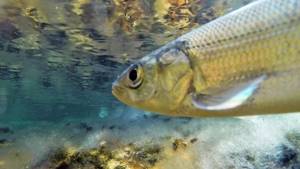
The omul feeds on zooplankton, so it is considered an omnivorous fish. Its favorite food is amphipods or epishura crustaceans. But when basic nutrition is not enough, it happily eats invertebrates, small fish, and insect larvae. Can feed on mollusks and detritus.
Description
The first mention of this individual occurs in 1775. Even then, these marine inhabitants received their second name, “migratory whitefish.” Omul is endemic. Lives exclusively in the waters of Lake Baikal. Able to swim to nearby rivers only during the spawning period. One of the most famous habitats near Lake Baikal is the Kara Sea. According to the existing hypothesis, during the next spawning period, some fish were unable to return to their previous habitat. So she remained to live in the Kara Sea.

In representatives of this species of Siberian marine individuals, the mouth is located at the end of the head. Looks forward. The jaws appear to be the same size; the upper jaw does not protrude. The head is small and elongated.
The center line of the body is exactly located between the eyes. The center line of the body passes through the rather large eyes. The fish is a bony fish, not a cartilaginous fish. This individual has a pleasant brown or green coloring of the upper central part. The sides and belly are mostly silver in color. Often darkish spots can be seen on the upper fin and head. The body has an oblong elongated shape. This contributes to its rapid movement in the marine environment.
How much does this type of fish weigh? On average, the size of an adult fish ranges from 25 to 38 centimeters, and weight can range from 250 grams to 1.5 kilograms.
Spawning
Spawning for this fish lasts from late September to late October. But she goes out into the river already in August, since it takes at least a month for her to go to the spawning site. All fish participate in reproduction from 7-8 years of age, some Baikal species earlier. Each fish spawns only a few times, since sexual maturity ends at 11-13 years of age.
The omul travels quite far to spawn, sometimes 1500 kilometers from its habitat. At the same time, it avoids coastal areas and shallow waters. Does not feed during spawning. At first, the fish move in large schools, gradually breaking up into small schools.
Attention!
Unlike the Arctic, the Baikal omul begins to spawn at 5-6 years of age. He doesn't go that far into the river, swimming close.
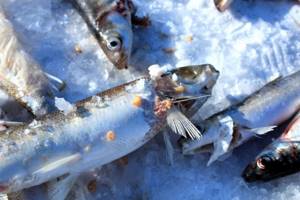
Spawning begins at a water temperature of 40. The female can lay 60-70 thousand eggs. But now the fertility of these fish has decreased. Young females lay 7-8 thousand, and in large individuals the number of eggs does not exceed 20 thousand. After spawning, the fish return back to their habitats. At the same time, she begins to have an active “zhor.”
Caviar develops only in clean water at a temperature of 1-30. An influx of oxygen is required, so omul spawns on a sandy or pebble bottom, where the current is shallow and good. The caviar is not sticky and breaks up into individual eggs. The fry appear after 200 days, when the water warms up to 10-120. Usually, out of 10 thousand eggs, no more than 10 fry survive. At first they stay in flocks in the same place, then swim with the flow to their permanent habitat.
Attention!
From the end of August to the end of October there is a ban on fishing for omul in all water bodies. But despite the heavy fines, the omul population is still decreasing.
Benefits and harm to the body
What are the benefits of omul fish? First of all, because it belongs to ecological products, since it lives only in very clean water.
In addition, the beneficial properties are explained by its composition:
- vitamin A – increases visual acuity;
- vitamin B (in terms of its content, omul is superior to other types of fish) – supports the functioning of the reproductive and nervous systems;
- Vitamin D – strengthens bones, prevents fractures, helps preserve teeth;
- Vitamin E is a natural antioxidant that slows down the aging process; it also strengthens the heart muscle, gives strength to the walls of blood vessels, and dissolves blood clots;
- fatty acids – strengthen the immune system, activate the functioning of the heart and blood vessels, stimulate brain activity, relieve inflammation;
- microelements - essential for the functioning of the body.
There is no cholesterol in omul meat, and the substances it contains reduce blood viscosity and minimize the risk of heart attack and stroke.
Northern fish meat is digested very quickly (in an hour and a half) and of high quality (95%). Animal meat is only 85% digestible. In addition, the process lasts about 5 hours.
Omul will be an excellent alternative to meat dishes, especially for those with a weak stomach. It will bring invaluable benefits to people suffering from frequent colds, pathologies of the heart and kidneys, hormonal imbalances, and infertility.
Cold smoked omul is especially beneficial, as it retains all the beneficial substances unchanged. In addition, it can be stored for two weeks and goes well with all products. It is eaten plain, added to salads, and used to make sandwiches, canapés and main courses, to which it imparts a delicate taste.
Cold smoked omul, camp style
Despite the beneficial properties of fish, there are also contraindications to its consumption - individual intolerance, hyperfunction of the thyroid gland, the presence of stones in the urinary system. It is also worth considering that Baikal omuls, unlike Yakut ones, are infected with parasites, which is why, in addition to benefit, they can also cause harm to the body.
During pregnancy, omul can only be eaten in heat-treated form. Raw, salted and smoked fish are contraindicated.
Fishing Features
Omul is a very popular fish for fishing. Catching it is interesting, it is a kind of sport. This is a rather cunning fish, so many people catch it for fun. Amateur fishing is allowed everywhere except Lake Baikal. Fishing is prohibited only during spawning season. Summer and winter fishing are interesting, although they have their own characteristics.
In summer it is better to catch omul from the shore, but you can also fish from a boat. It is best to use a float rod or spinning rod. This fish bites on moving bait. You need to take a lot of different baits with you, since this fish is capricious, it is not known what it will like. Small baits of different colors are better. Most of all she loves red, pink, orange.
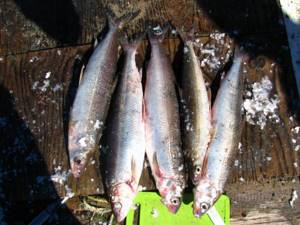
The following attachments are used:
- worms;
- flies;
- live bait;
- pieces of meat;
- red foam.
Important!
The omul has very thin lips, so it is recommended to use a landing net when fishing. And it is better to use hooks without a barb.
Night fishing is popular and can be even more productive. An interesting method is when they illuminate the water with a spotlight from a boat. The crustaceans flock to the beam of light, and the fish themselves come after them. They also fish at night using a donk; it is good to use different flies as bait. They are made from any bright shiny material, most often from beads.
In winter, you definitely need bait from crustaceans, since the omul moves little. Winter fishing through the hole “sneak peek” is popular. By looking into the water, you can evaluate the behavior of the fish, adjust the fishing method and choose the bait that it would like.
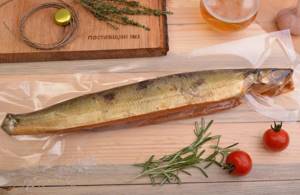
The advantage of winter fishing is that at this time of year the omul stays in schools. When the whole school approaches the hole, you can catch a lot of large fish.
Fishing for omul is an exciting activity. And when choosing the right bait, it is also useful. Photos from the most successful fishermen amaze with the richness of the catch.
Varieties
Depending on their habitat, omuls are divided into the following subspecies:
Yakut
Many fish lovers know about the taste of omul and that it can only be obtained in Lake Baikal. But this opinion is wrong. It is an undeniable fact that the bulk of the Omul catch falls on Baikal. However, often fish can be found not only in the nearest rivers connecting to the lake by tributaries. One species of omul lives in the Arctic Ocean. This is where the Yakut omul lives. Its distinctive feature is that it chose a completely different habitat. The climate of the Arctic Ocean is significantly different from Baikal. The water in these places is very salty. And representatives of the crustacean class are completely different. All these factors significantly influenced the taste and aroma of this fish.
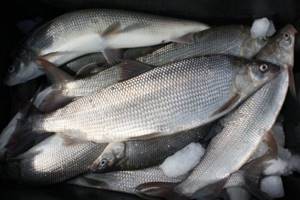
Many argue that the Yakut omul is fattier than the Baikal one. This is not at all surprising. Because to survive in cold waters, fish accumulate a lot of fat. In the human stomach, such fat is easily digested. That is why it cannot harm a person in any way. It is important to note that the Yakut omul contains much more vitamins contained in fish oil. The taste of this cold-resistant fish also has significant differences. It is extremely difficult to describe them in words. In order to understand the distinctive characteristics of two types of fish, it is necessary to be able to try them simultaneously. This is how it is possible to taste the superiority of each species.
The Yakut version of the omul has learned to survive well in harsh cold conditions. It does not prefer the distant depths of the Arctic Ocean due to the salinity of the water, but chooses for its habitat the coastal zones of those places near which there are large rivers flowing into the ocean. Here the water is fresher, and the flowing rivers fill the habitat of the omul with various delicacies: crustaceans, fry, and insect larvae. They allow the fish individual to build up fat in itself.
If we compare the spawning of both types of fish, it is absolutely identical. It also swims long distances, looking for a place to breed. The entire journey there and back takes the fish about three to four months, starting at the end of summer and ending at the beginning of winter. During this period of time, the fish manages to get to the spawning site, go through the laying of eggs, and return back. From spawning to spawning, an individual of the Yakut species takes a period of several years.
Yenisei
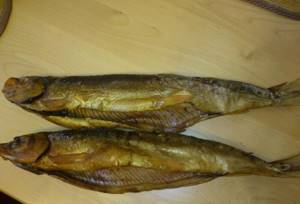
This subspecies got its name from the habitat of the individuals. They live in the coastal areas of the Yenisei Bay. They prefer to descend to a depth of less than 5 meters. At times when the current drives salty sea water into the bay, the Yenisei omul swims to the southern part of the bay.
If we consider what the omul eats, we can distinguish the following “delicacies”: gammarus, mysids and crustacean plankton.
The Yenisei omul begins to prepare for spawning in advance. Already at the beginning of July. To reproduce, it swims to a distance of up to 1.5 thousand kilometers, like other members of the family. Spawns once every few years.
In terms of taste, it is in no way behind its relatives. Fresh meat is tender and white. When cooking, it can be used boiled, fried or steamed.
How much does a finished dish cost? The price of the finished dish is decent. Every gourmet can taste this delicious delicacy.
Northern

Settles in the north of Lake Baikal. That's why it got its name. A distinctive feature of this species is that it lives mainly in warm coastal waters, full of waste products. Average weight is 250 grams. Body length can reach 40 centimeters. The basis of the body is bone, not cartilage. Northern omul meat is more tender than all other options. True connoisseurs of fish should try and savor the aromas of this particular fish. The price of the dish will please you.
Arctic

Another subspecies of this fish is the Arctic omul. You can see it in more detail in the photo. Individuals of this subspecies are also valued in different world cuisines. The taste of this fish is amazing. The meat is very tender, white, and has no bitterness. On average, each fish of this genus weighs approximately 1 to 2 kilograms. These inhabitants of sea latitudes can be found in the area of the Arctic Ocean.
Reproduction of the Arctic omul occurs, like its other “relatives”, at the same time.
Fresh fish contains a lot of fatty substances. However, despite this, fish is a low-calorie type. This fish is easily and quickly perceived and processed in the human body.
Eating
Now only the Arctic variety is of commercial importance. The price per kg of omul fish is 500-600 rubles; in Siberia it costs less. It has tender, tasty meat with a high fat content. Therefore, there is absolutely no need to add oil when cooking.
But despite the large amount of fatty acids, this fish is considered low-calorie - it contains only 88 kcal. This is a dietary food that is useful even for obesity and pathologies of the gastrointestinal tract.
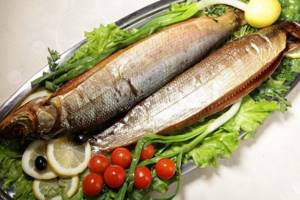
In addition to unsaturated fatty acids, omul meat is rich in other useful substances:
- amino acids;
- proteins;
- B vitamins;
- vitamins PP, E, A, D;
- minerals.
It is recommended to use it for diseases of the heart, kidneys, nervous system, blood thickening, infertility, and frequent colds. It is useful for children and women with hormonal imbalances. Contraindicated only in case of individual intolerance.
Attention!
Almost all of the Baikal omul is infected with parasites. Therefore, it can be eaten only after heat treatment or salting.
Omul is used to prepare many dishes. It has few bones, the meat is considered a delicacy. It is delicious in any form: fried, boiled, baked. Fishermen make rich fish soup from this fish. It is also used for preparing sauces, casseroles, aspic, and pie fillings.
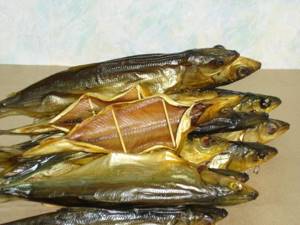
There is a specific dish that is prepared only from Baikal omul. It's called gaghutai. It is a fillet without bones and skin, filled with a special brine. It includes salt, vinegar, vegetable oil and spices. After this preparation, local residents eat fillet within a few hours.
Pickling omul is popular. Many people prefer the dry method, when the fish is not gutted, only the gills are removed. It is preferred by fishermen. The fish is rubbed with salt and topped with nettles. During normal salting, it is gutted and salted on all sides. But some people don’t like the specific aroma of lightly salted omul. Therefore, it is often smoked and boiled. You can fry and bake without oil.
You can find a wide variety of omul products on sale. In addition to fresh frozen fish, salted or smoked fish is also sold. It costs from 800 rubles per kg. Straws or pieces of fillet are popular; they cost more – from 1,500 rubles. Various canned foods are sold in their own juice or tomato. The price for a standard jar is from 200 rubles. These canned foods are considered dietary food.
Salmon fish are considered the most delicious. One of them is omul. Due to its high nutritional value, the number has greatly decreased. Therefore, only recreational fishing is now allowed. There is a serious fine for poaching or catching during spawning. You can easily buy omul in any form in the store. This diet food is beneficial for everyone.
